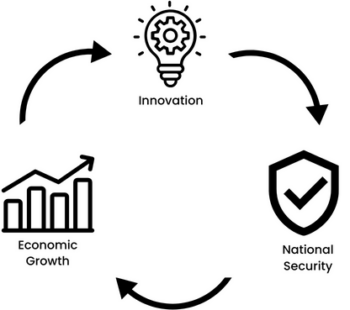The Rise in Dual-Use Technologies: A Paradigm Shift

In today’s rapidly evolving technology landscape, dual-use technology has emerged as a crucial frontier with profound implications for the future of innovation, national security, and economic growth. Inherently, all technologies tend to be susceptible to more than one application. At its core, dual-use technology refers to innovations that have both civilian and military applications.
Table of Contents
I. Introduction
II. Great Power Competition and Dual-Use Technology: Impacts Beyond Defense
III. The Role of Public/Private Collaboration in Supporting Innovation
IV. Transformative Dual-Use Technologies
Critical Dual-Use Technologies that Drive Global Economic Development
V. Emergence of Defense Dual-Use Technology Accelerators (D2UTA)
NATO DIANA
FCAS Accelerator – HENSOLDT
BLAST
Israel Aerospace Industries Innovation Center
Allied Defence Accelerator
VI. Innovation Ecosystems
VII. Looking Ahead: The Future of Engaging with Dual-Use Technologies
I. Introduction
For the purpose of this overview, we define dual-use technologies as those with both government and commercial use cases.

The rise in dual-use technology reflects a transformative post-Cold War research and development (R&D) paradigm shift. At the height of the Cold War, the federal government conducted the majority of technology R&D. Today, the private sector assumes that role, and this shift has resulted in a robust and fast-moving innovation ecosystem that is simultaneously driving economic prosperity through commercial applications and addressing national needs.
Great power competition is the key driver of the US government’s growing interest in commercial technologies that could augment current capabilities. Maintaining American and allied technology leadership is critical to deterring conflict.
The US federal government seeded many of the technologies that went on to significantly impact the economy and the quality of our daily life, such as GPS, Siri, and the internet. Today, entrepreneurs are building off of these government-supported technologies to create hardware and software that can enhance defense capabilities, build resilience and redundancy, and introduce a more diverse set of capabilities into the defense ecosystem.
Technology is increasingly a battleground in the realm of strategic competition, especially between the US and China. The US is restricting the trade of key technologies with China and encouraging EU member states to follow its lead. This great power competition between China and the US has spurred the development of innovative dual-use technologies with the end goal of selling to the US Department of Defense (DoD).
Europe, and France, in particular, need to build up a sovereign cloud capability, so that they can develop collaborative defense programs with the best possible functionality.
The overarching investment benefits are clear: investments in dual-use technologies not only strengthen national security but also stimulate economic growth. Further, defense innovation initiatives often generate spillover effects that benefit the broader economy, contributing to job creation, knowledge sharing, and technological advancements.
II. Great Power Competition and Dual-Use Technology: Impacts Beyond Defense
The geopolitical side of innovation is unavoidable. Every startup that is developing new technologies, regardless of its intended use or customer, is a geopolitical actor that is (intentionally or unintentionally) helping the effort to sustain American and allied technology leadership.
Great power competition is often talked about in a defense context, as it’s usually discussed by stakeholders in defense or defense-adjacent worlds. While high-level policy discussions can make this issue seem like a distant academic problem, it already actively affects our everyday lives. Should competition turn into an all-out conflict, we would see immediate and destructive impacts to our way of life.
Innovation is central to maintaining American and allied technology leadership—the answer to the threat posed by near peer adversaries is to keep innovating. The ultimate goal is not to produce weapons of war, but to deter conflict, maintain peace, and save and maintain lives. Victory is the prevention of conflict altogether.
However, great power competition goes well beyond our traditional notions of defense and affects virtually everything, from the environment, medicine, and energy, to education, agriculture and food security, consumer electronics, and everything in between. A startup that is working on education technology to inspire the next generation of STEM professionals is just as important as the startup that is developing AI-powered autonomous platforms to augment military systems.
III. The Role of Public/Private Collaboration in Supporting Innovation
Public/private collaboration is critical to realizing the full benefits of innovation—cooperation between the DoD and the technology industry is more important now than ever. The case for collaboration is supported by history. For example, the relationship between the DoD and Silicon Valley dates back to the early days of the Cold War and significantly strengthened after the Soviet Union’s launch of Sputnik triggered the space race.
Throughout the Cold War, the DoD funneled money into Silicon Valley through subcontractors, and Stanford University helped foster the entrepreneurship that transformed the region. Additionally, a combination of state and federal laws and regulations helped create the conditions that developed Silicon Valley into the world’s premier technology hub. Many of the core technologies upon which today’s innovations are being developed were seeded by the DoD and other government agencies in order to address capability needs during the Cold War.
A substantial number of today’s transformative technologies originated as defense projects, including the internet, GPS, and Siri, to name a few. Others were the product of civil space projects, supported by NASA, including cordless tools, modern water filtration systems, satellite television, etc.
Furthermore, the Small Business Administration has been one of the US’s largest sources of seed capital since 1958. Small Business Innovation Research (SBIR) and Small Business Technology Transfer (STTR) programs are used by multiple federal agencies to support R&D and the prototyping of new products.
Governments help facilitate innovation through four fundamental avenues: procurement, risk mitigation, collaborative efforts, and the establishment of standards or regulations. Often, a key role of the government in fostering innovation is as the customer and/or end user.
In recognition of the paradigm shift from government-driven R&D to commercial-driven R&D, the government has sought to more substantively engage with the non-traditional ecosystem. The DoD has established numerous entities that are specifically focused on accessing the startup ecosystem and bringing new companies into the defense ecosystem. These include the Defense Innovation Unit (DIU), AFWERX, SpaceWERX, NavalX, the National Security Innovation Network (NSIN), and the Army Applications Lab, among many others.
The DoD and the government have made progress in forging partnerships with non-traditional players, venture capital funds, private equity funds, and other commercial stakeholders. Its innovation components are expanding the Department’s access to new technologies. However, in addition to the cultural and institutional barriers mentioned above, the DoD and the private sector still struggle with the “Valley of Death” or the “Frozen Middle”, referring to the DoD’s ability to quickly transition technologies from prototype to end product via a contract mechanism. This is a problem that will take quite some time to solve. In the meantime, companies that desire to support the DoD must work within the system that exists.
Starburst Aerospace’s accelerator programs help the industry navigate these challenges by ensuring that startups are truly commercially viable dual-use companies that can scale independent of defense dollars. While SBIRs, STTRs, and other alternative sources of funding can serve as good routes for early-stage non-dilutive capital, companies should not depend on them alone for survival and growth.
IV. Transformative Dual-Use Technologies
Dual-use technologies have assumed an increasingly vital role in contemporary society. Understanding the intricacies surrounding this type of technology is critical, as it enables governments, industries, and policymakers to harness their revolutionary potential while effectively addressing ethical, regulatory, and security considerations.
Critical Dual-Use Technologies that Drive Global Economic Development
Advanced Materials: Innovative materials, such as those with exceptional strength, durability, and/or unique properties, have applications in aerospace and advanced manufacturing, as well as various defense systems.
Biotechnology and Advanced Medicine: Advances in biotechnology have dual-use potential, with applications ranging from advanced medical treatments to biodefense. This includes genetic engineering, synthetic biology, and the development of countermeasures against biological threats.
Future Generation Wireless Technology (FutureG): FutureG networks are distinct from existing networks like 5G due to various advances such as high-precision positioning, improved network reliability, greater energy efficiency, and better security. This is critical for ensuring secure and reliable communications, enabling technologies like the Internet of Things (IoT), and supporting advanced military communications.
Human-Machine Interfaces: A Human-Machine Interface (HMI) is a user interface or dashboard that connects a person to a machine, system, or device. HMI technology enables rapid mission planning and command.
Hypersonics: Hypersonic systems fly within the atmosphere for significant portions of their flight at or above 5 times the speed of sound and can cover vast distances in minutes. Hypersonics will have multiple civilian applications, including the launching of small satellites at a low cost. If satellites ever fail, hypersonic aircraft could be their failsafe.
Integrated Network Systems-of-Systems: Integrated Network Systems-of-Systems is the ability to communicate, share information in real time, and command and control effectively in a contested electromagnetic environment. It must allow any sensor or shooter to engage in combat, and it must be able to integrate disparate systems. An interoperable network that leverages emerging capabilities across the electromagnetic spectrum, such as 5G, software-defined networking, and radios, as well as modern information exchange techniques, will allow governments to better integrate many diverse mission systems and provide fully networked command, control, and communication that is capable, resilient, and secure.
Integrated Sensing and Cyber: ISC technologies can be used to improve situational awareness, decision-making, and command and control in both civilian and military settings. These technologies combine sensing and communication systems to utilize wireless resources efficiently, while realizing wide area environment sensing.
Microelectronics: Microelectronics are circuits and components that serve as the “brain” to human-made electronic functional systems. They have touched every aspect of modern life, such as the creation of personal computers, cell phones, fax machines, microwave ovens, calculators, and more. Virtually every military and commercial system relies on microelectronics, and it’s critical to own the manufacturing and supply chain process.
Quantum Science: Quantum Science is the study of physical properties at small, even atomic, scales. Quantum technologies promise to dramatically increase computing power and speed, enabling machines to solve problems beyond the capacity of the current generation of computers.
Space Technologies: Technologies related to space exploration, satellite communication, remote sensing, and space situational awareness are crucial for both military and civilian applications, including navigation, communication, surveillance, and reconnaissance.
Renewable Energy Generation and Storage: Sustainable and efficient energy sources are critical for military operations, defense infrastructure, and reducing dependence on vulnerable supply chains. Renewable energy generation and storage includes solar wind, bio-based, and geothermal technologies, advanced energy storage, electronic engines, and power grid integration.
Trusted Artificial Intelligence (AI) and Autonomy: AI and machine learning have implications for various sectors, including defense, intelligence, cybersecurity, and autonomous systems. These technologies are used for data analysis, pattern recognition, decision-making, and more. AI holds tremendous promise to improve the ability and function of nearly all systems and operations. Trusted AI with trusted autonomous systems are imperative to dominate future conflicts.
V. Emergence of Defense Dual-Use Technology Accelerators (D2UTA)

In the last few years, we have seen the emergence of the launch of dual-use technology accelerators in partnership with the private sector and public government institutions. This is the dawn of a new era, brought on by a renewed interest in defense technology with the onset of recent geopolitical conflicts. The health and safety of civilians depend on swift and decisive action from the government.
While there are numerous opportunities for startups to support dual-use technology development aims that solve critical defense and security issues, there are just as many challenges; funding is at the top of this list. Governments must fund these initiatives, considering the long-term impacts regarding national security measures.
The cost-benefit analysis of a government-funded dual-use accelerator program is clear: upfront capital costs are nil when looking at the market opportunities surrounding commercialization. GPS initially began as a technology for military use only, but it eventually paved the way for a new era of prosperity and innovation, particularly in the realm of startups that capitalized on the existing infrastructure. Companies like Google Maps, Uber, Instacart, and many more have built billion dollar enterprises as a result of government-funded technology developments.
Dual-use accelerator programs provide access to capital, mentors, and government connections, which are all critical for startups at the early-stage. We’ve highlighted examples below on how the startup accelerator model supports the innovation flywheel to further increase and enhance cooperation amongst various government agencies around the globe. The ties between commercial startups and national governments have a rich history that must continue to evolve as technological advancements accelerate.
NATO launched the Defence Innovation Accelerator for the North Atlantic (DIANA) to provide deep tech and dual-use innovators access to resources from across the Alliance/allied nations. DIANA focuses on nine key emerging dual-use technologies: artificial intelligence, data, quantum-enabled technologies, autonomy, biotechnology, hypersonics, novel materials and manufacturing, energy and propulsion, and space.
The accelerator program is poised to become an invaluable resource for NATO member nations, enabling them to harness the power of dual-use technologies for data analysis and much more. It will serve as an innovative addition to NATO’s existing capabilities, offering real-time support and augmenting the expertise of decision-makers.
Built with a focus on transparency, accountability, and ethical considerations, DIANA adheres to NATO’s values of collective defense, democracy, and respect for human rights.
A German champion in the defense electronics industry and a key partner of the Future Combat Air Systems (FCAS) project through the joint venture FCMS, HENSOLDT launched the first ever iteration of the FCAS Accelerator, powered by Starburst Aerospace. The program is fostering the dual-use ecosystem of European civil technologies by identifying and accelerating dual-use and defense applications.
Led by countries Germany, France, and Spain, the FCAS project is a revolutionary European program, dedicated to developing the Next Generation Weapon System (NWGS) by 2040. This system of systems program leverages the most disruptive technologies to incorporate artificial intelligence, disruptive sensors, and cutting-edge production materials into the 6th generation fighter development program.
HENSOLDT selected five Technology themes for the first iteration of the FCAS Accelerator: Disruptive Sensors, Enabling AI, 3D Printed Electronics, Electronic Materials & Components, and Innovative RF Technologies.
Based in Paris, France, BLAST (Boost and Leverage Aerospace and Defense Technologies) is an early-stage accelerator program, focused on startup technologies within the verticals of aviation, space, and defense.
The program is in collaboration with Banque Publique d’Investissement (BPI), ONERA, the French National Aerospace Research Centre, two French universities, SATT Paris-Saclay and the Institut Polytechnique of Paris, and supporting partners: CNES, the French National Space Agency, MBDA France, the French Space Command, and the French Defence Innovation Agency (AID).
BLAST is a driving force behind the success of numerous innovative startups in the aerospace industry.
Startups who participated in past cohorts collectively raised over 20 million euros, a testament to the effectiveness of BLAST in facilitating growth and securing funding for emerging dual-use businesses.
Israel Aerospace Industries Innovation Center
Israel Aerospace Industries (IAI) is Israel’s major aerospace and aviation manufacturer, producing aerial and astronautic systems for both military and civilian use. IAI launched the Accelerate Space Technologies and Research in Aerospace (ASTRA) accelerator program.
The mission is to advance space technology and inspire a new generation of entrepreneurs in Israel. The program is designed to support startups by providing support with access to an innovation hub, business development and funding, securing proof of concept, commercialization strategy, product-market-fit, coaching, mentoring, and more.
Startups and teams who have participated have focused on developing AI-based solutions for aerospace, radar, robotics and autonomy technologies.
The Innovation Center helps speed up the development of advanced technology-based ventures with aerospace applications. It employs open innovation methodologies to encourage technological diversity and in-house entrepreneurship alongside collaboration with potential partners.
The Allied Defence Accelerator was the first of many programs to align allied nations with startups and entrepreneurs around the world to solve mission-critical challenges together.
The joint initiative between the US Air Force and British Ministry of Defense focused on finding, funding, and advancing innovation and technology that give advantages to allied military personnel and operations in the space domain. It was specifically designed to bolster technology start-ups and small and medium-sized enterprises to harness the power of their ingenuity and innovation.
Selected startup technology companies and builders participated in a 5-week course of specialized business mentoring and training in the hopes of securing a place to pitch at the first International Space Pitch Day, in front of senior US, UK, and NATO military leaders at the Defense Space Conference in London, and received a contract to speed up their innovation.
VI. Innovation Ecosystems
The current innovation ecosystems across the globe are the product of public/private collaborations and investments over many decades. Sustained collaboration amongst stakeholders is critical to the future of innovation. This innovation, in turn, not only prevents war but also strengthens us domestically through broad-based benefits across society. At Starburst Aerospace, we are passionate about working with entrepreneurs, accelerating the development of emerging and disruptive technologies, supporting the expansion of our domestic and allied innovation ecosystems, and helping startups raise, grow, and scale.
As the ecosystem grows, it stimulates economic growth which enhances the quality of daily life for growing numbers of Americans.In the US, Innovation is spreading from traditional hubs like Los Angeles, San Francisco, Palo Alto, Austin, New York, and Boston to small and medium-sized cities like Tulsa and Indianapolis. As the innovation ecosystem becomes more distributed, more Americans are able to participate in maintaining and fostering it. This approach should be modeled globally in allied nations.
We see five key stakeholders in the innovation ecosystem:
- Governments make the regulations and policies that influence innovation. These entities seed the development of new technologies and/or serve as a key or primary customer or end user. Their precise needs can influence the characteristics or frameworks of new technology.
- Corporations bring vital resources, infrastructure, and institutional expertise for scaling products. They have the resources to invest in R&D and facilitate technology transfer.
- Universities conduct R&D, create new IP, serve as partners to the government and the private sector, and critically help develop the workforce.
- Startups are the engines of innovation, often pushing the boundaries of what’s possible. Their agility and willingness to take risks are essential for exploring cutting-edge applications.
- Private Capital: Venture capital and private equity funds are an important source of capital to early-stage and growth-stage companies. A government-funded accelerator helps to derisk innovation by empowering startups to seek private investment.
In a perfect world, all five stakeholders would work together cohesively to leverage the security, economic, and societal advantages of the world’s most dynamic innovation ecosystem. In biology, ecosystems result from complex and varied interactions that flourish amidst persistent structural reconfigurations. These ecosystems are agile. When considering innovation ecosystems, we know that there is much potential to rapidly spur innovation. While we are gradually making progress, there are structural, cultural, and incentive-related barriers that prevent true symbiosis.
VII. Looking Ahead: The Future of Engaging with Dual-Use Technologies

Technologies such as artificial intelligence (AI), autonomous systems, and quantum technologies are changing the way that the world operates. Energy resilience is becoming a key factor in maintaining safety and security around the world. The future of these technologies are having a profound impact on security, and each government must keep up with the pace of civilian innovation.
Looking ahead, technological and broader political, social, economic, and environmental trends may result in a future marked by uncertainty, complexity, and rapid change. Chips, electronics, and AI stand as the leading sub-sectors for both funding and innovation within the dual-use market.
Given the dual-use nature of many new and emerging technologies, EU institutions and Member States should work to broaden their engagement and mutual understanding. According to a report by the European Parliament, the future battlefield will be shaped by the interaction of technology with various political, social, economic, environmental, and technological strategic trends.
In particular, the study investigated the implications of possible advances in: (1) artificial intelligence, machine learning, and big data; (2) advanced robotics and autonomous systems; (3) biotechnology; (4) technologies for the delivery of novel effect; (5) satellites and space-based technologies and assets; and (6) human-machine interfaces. The study identified several cross-cutting implications of new and emerging technologies for future battlefield dynamics and European defense. The smartest and fastest robots will win.
For innovators in the US, a more strategic solution would be to make the DoD a better customer by awarding larger contracts more quickly and enhancing communication regarding current capabilities and problem sets. The last piece is to streamline and clarify the entire process.
Startups can’t rely on the defense departments alone, so for their resilience, they need to scale internationally and deploy outside defense, energy, space, and satellite cybersecurity. The dual-use nature of these technologies allows defense investments to have positive ripple effects in various sectors, including manufacturing, healthcare, transportation, and energy. As a result, defense-related spending contributes to local and national economic development, enhancing overall prosperity.
Resources
National Defense Science & Technology Strategy 2023, US Department of Defense: https://www.cto.mil/ndsts/
Critical Technology Areas, United States Department of Defense: https://www.cto.mil/usdre-strat-vision-critical-tech-areas/
Emerging and Disruptive Technologies, NATO: https://www.nato.int/cps/en/natohq/topics_184303.htm
Accelerating Hardware Development, National Security Innovation Capital: https://www.nsic.mil/
Revisiting The Government’s Role in Catalyzing Modern Innovation, Deloitte Insights: https://www2.deloitte.com/us/en/insights/industry/public-sector/role-of-government-in-innovation.html
New Program Helps Dual-Use Hardware Startups Accelerate Product Development, US Department of Defense: https://www.defense.gov/News/News-Stories/Article/Article/2772358/new-program-helps-dual-use-hardware-startups-accelerate-product-development/
The Changing Landscape of Dual-Use Technology: Will Startups Make Us More Secure?, MassChallenge: https://masschallenge.org/articles/dual-use-innovation/
Innovative Technologies Shaping The 2040 Battlefield, European Parliamentary Research Service: https://www.europarl.europa.eu/RegData/etudes/STUD/2021/690038/EPRS_STU(2021)690038(ANN1)_EN.pdf
Reliance on Dual-Use Technology is a Trap, War on The Rocks: https://warontherocks.com/2022/09/reliance-on-dual-use-technology-is-a-trap/
Starburst 2023 © All Rights Reserved

